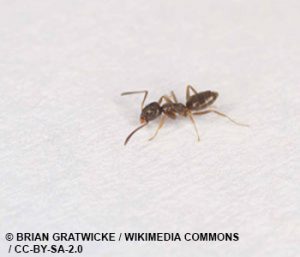Odorous House Ants
Biology
The odorous house ant also called the “coconut ant” is found throughout the United States. This ant gets it’s name from the odor it creates when crushed; it is described as the smell of rotten coconuts. The odorous house ant colonies may contain up to 100,000 ants with many queens. Super colonies may exist where there is abundant food, water, and ideal environmental conditions.
Feeding Preferences
When indoors, the odorous house ants prefer sweet food debris or liquids during the warmer temperatures. However, they have been known to feed on high protein and greasy foods. Outdoors, they feed on honeydew, plant secretions, seeds, and different types of insects.
Transmitted Diseases
The odorous house ant is not a carrier of diseases.
Habits
Inside, these ants usually construct their nest in wall voids, around hot water pipes and heaters, and in openings around sinks and cupboards.
Outside, they are normally found in the nest of larger ants, usually under objects. They are most likely to enter structures when their food supply is depleted such as during rainy weather, leaf fall in the autumn, or cold temperatures. The odorous house ant is known to be a scavenger and a predator species of ant, although it does not sting or bite humans.
Our service technician will perform a thorough inspection on the exterior and interior of your structure to locate all problem areas and properly identify the pest you are having. All programs are specially designed to target the pest that is infesting your structure.
Structural Pest Ant Program
Our service technician will perform a thorough inspection on the exterior and interior of your structure to locate all problem areas and properly identify
the pest you are having. All programs are specially designed to target the pest that is infesting your structure.

